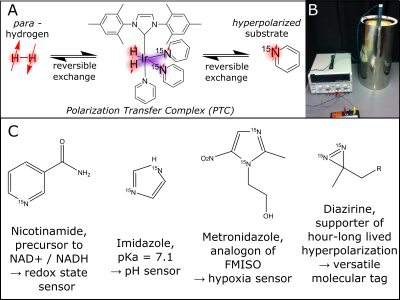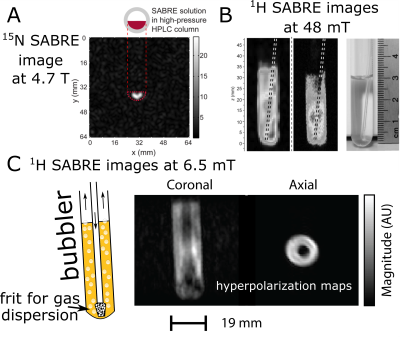3063
Recent advances in low-cost, rapid Hyperpolarization Chemistry: from portable NMR to low-cost molecular MRI.1Chemistry, Duke University, Durham, NC, United States, 2Medicine, Duke University, Durham, NC, United States, 3A. A. Martinos Center for Biomedical Imaging, Massachsetts General Hospital, Charlestown, MA, United States, 4Physics, Harvard University, Cambridge, MA, United States, 5Vanderbilt Univesity Institute for Imaging Science, Nashville, TN, United States, 6Physics, Chemistry, BME, Radiology, Duke University, Durham, NC, United States
Synopsis
NMR and MRI are inherently low sensitivity techniques. Hyperpolarization technology overcomes this problem by enhancing MR signals by 10,000-fold or more. However, most hyperpolarization techniques are complex, expensive and slow. We describe hyperpolarization chemistry that is simple, low-cost, and fast or even continuous. Specifically, we describe recent advances in parahydrogen-induced polarization, combined with various MR detection schemes to establish 1) miniaturized NMR spectrometers, 2) NMR structural elucidation with reduced limits of detection, and 3) low-cost biomolecular imaging.
INTRODUCTION
NMR and MRI are cherished for their molecular specificity and contrast rich images but suffer from low sensitivity. Hyperpolarization approaches challenge these paradigms. The presented research advances parahydrogen based hyperpolarization chemistry 1, 2 that is simple, low-cost, and fast or even continuous. The emerging technology works directly in room temperature liquids and at any magnetic field. This versatile hyperpolarization approach even obviates the need for high-field superconducting magnets, enabling new opportunities for novel MR platforms. These include 1) sensitive miniaturized NMR spectrometers, 2) molecular structure elucidation with low limits of detection, and 3) low-cost, molecular imaging by combination with low- and ultra-low-field MRI.METHODS
Parahydrogen (the antialigned nuclear spin isomer of H2) is bubbled through room temperature solutions where spin order is transferred from parahydrogen to substrates using hyperpolarization transfer catalyst as depicted in Fig. 1. This method is known as SABRE (Signal Amplification By Reversible Exchange).2 We focus on two recent variants of this technique, SABRE-SHEATH3 (SABRE in Shield Enables Alignment Transfer to Heteronuclei) and LIGHT-SABRE (Low-Irradiation Generates High Tesla SABRE).4 The beauty of SABRE-SHEATH stems from high reliability and simplicity, requiring only a set of µ-metal shields to reduce the magnetic field to about 5 mG (500 nT). Operation at 5 mG matches nuclear spin energy levels on the hyperpolarization catalysts to promote hyperpolarization transfer. LIGHT-SABRE, on the other hand, is attractive because it can be implemented at any magnetic field and enables continuous and repeated hyperpolarization. In turn, we can perform averaging and multidimensional NMR on hyperpolarized signals. LIGHT-SABRE works by applying soft RF-pulses to the hyperpolarization catalysts. We show that both LIGHT-SABRE and SABRE-SHEATH are enabling technologies for zero-field magnetometers and benchtop NMR spectrometers for use as sensitive and portable NMR modalities. We also design improved LIGHT-SABRE pulse sequences at low (35 mT) and high (8.5 T) magnetic fields. Finally, we couple SABRE-SHEATH and LIGHT SABRE with low-field MRI instruments to enable biomolecular imaging with low-cost technologies.RESULTS
First, we present data illustrating our advances in hyperpolarization chemistry. We have demonstrated that SABRE-SHEATH significantly broadens the substrate spectrum of hyperpolarizable compounds.5 Additionally, we have performed SABRE-SHEATH in pure aqueous solutions to establish full biocompatibility.6 Our current foci are on NAD+/NADH to probe redox state, imidazole for pH mapping and metronidazole to probe hypoxia. (See Fig. 1 C) In addition, we have demonstrated that 15N2-diazirines represent versatile biomolecular tags, which can be incorporated in a wide range of biomolecules and retain hyperpolarization for over an hour.7, 8 Furthermore, we have illustrated direct hyperpolarization of long-lived 13C2 singlet states establishing compatibility with current hyperpolarized MRI experiments that detect 13C signals.9 Moreover, we have introduced LIGHT-SABRE pulses that are robust to magnetic field (B0) and RF (B1) inhomogeneities to give hyperpolarization levels comparable to those obtained with SABRE-SHEATH (~10% polarization, unpublished)
Taking advantage of these developments, we demonstrate the combination of our hyperpolarization technology with alternative low-cost detection schemes. We present the detection of SABRE-SHEATH hyperpolarized signals directly inside the µ-metal shields using sensitive, optically pumped atomic magnetometers establishing “NMR without magnets”.10 Next, we performed detection of SABRE-SHEATH and LIGHT-SABRE hyperpolarization with 1 T permanent magnet based benchtop NMR spectrometers.5 Finally, we provide MRI images of SABRE hyperpolarized signals acquired on a range of scanners (a 4.7 T super-con, a 48 mT permanent magnet and a 6.5 mT electromagnet as indicated in Fig. 2.
DISCUSSION
The presented advances in hyperpolarization chemistry illustrate that SABRE based techniques have advanced to the point that important applications are within reach. Specifically, the increased substrate scope, the achieved biocompatibility, and the demonstrated long-lived nature of the hyperpolarized signals overcome significant barriers. Next, our proof-of-concept demonstrations combining SABRE techniques with low-cost, low-field detection schemes indicate that it is possible to steer away from the market trend to ever stronger magnets (with ever-increasing price tags) while retaining chemical specificity and high sensitivity.CONCLUSION
Magnetic resonance techniques are powerful because of their sensitivity to structural changes and the ability to image deep inside tissue but are limited by low polarization. The presented hyperpolarization chemistry is relatively simple and general and overcomes the sensitivity limitations Therefore, new MR platforms with unexplored applications emerge. These includes 1) portable NMR devices, which could be used for metabolic screening of bodily fluids for example, 2) structural elucidation of biomolecules at physiological concentrations, and 3) low-cost and safe molecular MRI, which could be used to scan broad patient populations to monitor onset, progression and treatment of metabolic diseases. Specifically, we are developing individual molecular probes to image pH, hypoxia and redox state.Acknowledgements
The authors gratefully acknowledge the NSF (CHE-1363008 and CHE-1416268), NIH 1R21EB018014, U01 CA202229 and 1R21EB020323, DOD CDMRP W81XWH-15-1-0271 and W81XWH-12-1-0159/BC112431 and Duke University for financial support of this research.References
1. Bowers, C.R. & Weitekamp, D.P. Transformation of Symmetrization Order to Nuclear-Spin Magnetization by Chemical-Reaction and Nuclear-Magnetic-Resonance. Phys. Rev. Lett. 57, 2645-2648 (1986).
2. Adams, R.W., Aguilar, J.A., Atkinson, K.D., Cowley, M.J., Elliott, P.I., Duckett, S.B., Green, G.G., Khazal, I.G., Lopez-Serrano, J. & Williamson, D.C. Reversible interactions with para-hydrogen enhance NMR sensitivity by polarization transfer. Science 323, 1708-11 (2009).
3. Theis, T., Truong, M.L., Coffey, A.M., Shchepin, R.V., Waddell, K.W., Shi, F., Goodson, B.M., Warren, W.S. & Chekmenev, E.Y. Microtesla SABRE Enables 10% Nitrogen-15 Nuclear Spin Polarization. J. Am. Chem. Soc. 137, 1404-1407 (2015).
4. Theis, T., Truong, M., Coffey, A.M., Chekmenev, E.Y. & Warren, W.S. LIGHT-SABRE enables efficient in-magnet catalytic hyperpolarization. J. Magn. Reson. 248, 23-26 (2014).
5. Colell, J.F.P., Logan, A.W.J., Zhou, Z., Shchepin, R.V., Barskiy, D.A., Ortiz, G.X., Wang, Q., Malcolmson, S.J., Chekmenev, E.Y., Warren, W.S. & Theis, T. Generalizing, Extending, and Maximizing Nitrogen-15 Hyperpolarization Induced by Parahydrogen in Reversible Exchange. J. Chem. Phys. C 121, 6626 (2017).
6. Colell, J.F.P., Emondts, M., Logan, A.W.J., Shen, K., Bae, J., Shchepin, R.V., Ortiz, G.X., Spannring, P., Wang, Q., Malcolmson, S.J., Chekmenev, E.Y., Feiters, M.C., Rutjes, F.P.J.T., Blümich, B., Theis, T. & Warren, W.S. Direct Hyperpolarization of Nitrogen-15 in Aqueous Media with Parahydrogen in Reversible Exchange. J. Am. Chem. Soc. 139, 7761-7767 (2017).
7. Shen, K., Logan, A.W.J., Colell, J.F.P., Bae, J., Ortiz, G.X., Theis, T., Warren, W.S., Malcolmson, S.J. & Wang, Q. Diazirines as Potential Molecular Imaging Tags: Probing the Requirements for Efficient and Long-Lived SABRE-Induced Hyperpolarization. Angew. Chem. Int. Ed. 56, 12112-12116 (2017).
8. Theis, T., Ortiz, G.X., Jr., Logan, A.W., Claytor, K.E., Feng, Y., Huhn, W.P., Blum, V., Malcolmson, S.J., Chekmenev, E.Y., Wang, Q. & Warren, W.S. Direct and cost-efficient hyperpolarization of long-lived nuclear spin states on universal (15)N2-diazirine molecular tags. Sci. Adv. 2, e1501438 (2016).
9. Zhou, Z., Yu, J., Colell, J.F.P., Laasner, R., Logan, A., Barskiy, D.A., Shchepin, R.V., Chekmenev, E.Y., Blum, V., Warren, W.S. & Theis, T. Long-Lived 13C2 Nuclear Spin States Hyperpolarized by Parahydrogen in Reversible Exchange at Microtesla Fields. J. Phys. Chem. Lett. 8, 3008-3014 (2017).
10. Theis, T., Ledbetter, M.P., Kervern, G., Blanchard, J.W., Ganssle, P.J., Butler, M.C., Shin, H.D., Budker, D. & Pines, A. Zero-Field NMR Enhanced by Parahydrogen in Reversible Exchange. J. Am. Chem. Soc. 134, 3987-3990 (2012).
Figures

SABRE-SHEATH mechanism and select substrates.
A) Reversible Exchange Reactions of para-hydrogen and substrate on a polarization transfer complex (PTC) lead to continuous hyperpolarization buildup on the substrate. B) Magnetic shields employed to match nuclear spin energy levels, which promotes hyperpolarization transfer on the PTC.
C) Select examples of hyperpolarization substrates for imaging of redox state, pH, hypoxia and beyond.

15N and 1H SABRE images at various magnetic fields.
A) hyperpolarized 15N image on 20 mM 15N-Pyridine at 4.7 T
B) hyperpolarized 1H image on 100 mM Pyridine at 48 mT
C) hyperpolarized 1H image on 100 mM Pyridine at 6.5 mT